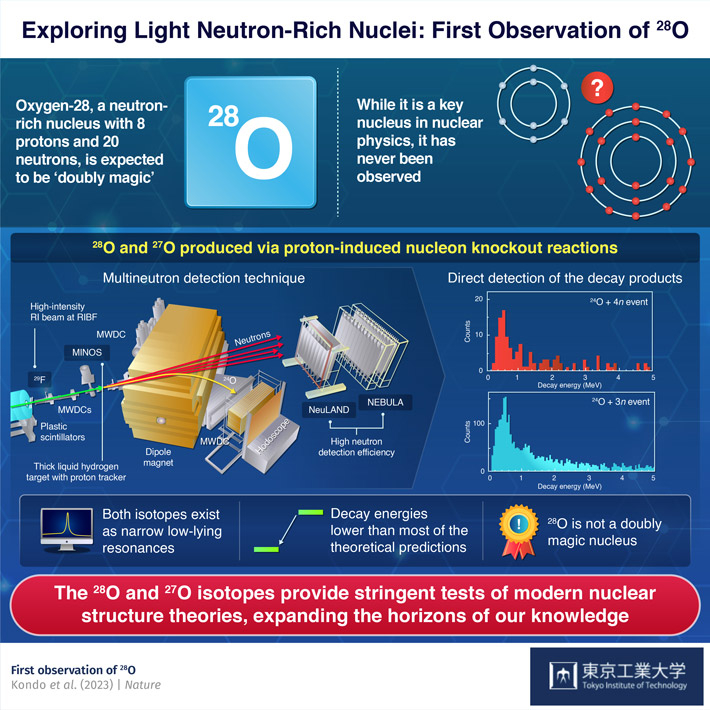Authors : |
Y. Kondo1,2,*, N.L. Achouri3, H. Al Falou4,5, L. Atar6, T. Aumann6,7,8, H. Baba2, K. Boretzky7, C. Caesar6,7, D. Calvet9, H. Chae10, N. Chiga2, A. Corsi9, F. Delaunay3, A. Delbart9, Q. Deshayes3, Zs. Dombrádi11, C.A. Douma12, A. Ekström13, Z. Elekes11, C. Forssén13, I. Gašparić2,6,14, J.-M. Gheller9, J. Gibelin3, A. Gillibert9, G. Hagen15,16, M.N. Haraken7,12, A. Hirayama1, C.R. Hoffman17, M. Holl6,7, A. Horvat7, Á. Horváth18, J.W. Hwang19,20, T. Isobe2, W.G. Jiang13, J. Kahlbow2,6, N. Kalantar-Nayestanaki12, S. Kawase21, S. Kim19,20, K. Kisamori2, T. Kobayashi22, D. Körper7, S. Koyama23, I. Kuti11, V. Lapoux9, S. Lindberg13, F.M. Marqués3, S. Masuoka24, J. Mayer25, K. Miki22, T. Murakami26, M. Najafi12, T. Nakamura1,2, K. Nakano21, N. Nakatsuka26, T. Nilsson13, A. Obertelli9, K. Ogata27,28,29, F. de Oliveira Santos30, N.A. Orr3, H. Otsu2, T. Otsuka2,23, T. Ozaki1, V. Panin2, T. Papenbrock15,16, S. Paschalis6, A. Revel3,30, D. Rossi6, A. T. Saito1, T. Y. Saito23, M. Sasano2, H. Sato2, Y. Satou20, H. Scheit6, F. Schindler6, P. Schrock24, M. Shikata1, N. Shimizu31, Y. Shimizu2, H. Simon7, D. Sohler11, O. Sorlin30, L. Stuhl2,19, Z. H. Sun15,16, S. Takeuchi1, M. Tanaka32, M. Thoennessen33, H. Törnqvist6,7, Y. Togano1,34, T. Tomai1, J. Tscheuschner6, J. Tsubota1, N. Tsunoda24, T. Uesaka2, Y. Utsuno35, I. Vernon36, H. Wang2, Z. Yang2, M. Yasuda1, K. Yoneda2, and S. Yoshida37
|
Affiliations : |
1Department of Physics, Tokyo Institute of Technology, Tokyo, Japan
2RIKEN Nishina Center, Saitama, Japan
3LPC Caen UMR6534, Université de Caen Normandie, ENSICAEN, CNRS/IN2P3, Caen, France
4Lebanese University, Beirut, Lebanon
5Lebanese-French University of Technology and Applied Sciences, Deddeh, Lebanon
6Institut für Kernphysik, Technische Universität Darmstadt, Darmstadt, Germany
7GSI Helmholtzzentrum für Schwerionenforschung, Darmstadt, Germany
8Helmholtz Research Academy Hesse for FAIR, Darmstadt, Germany
9Irfu, CEA, Université Paris-Saclay, Gif-sur-Yvette, France
10Institute for Basic Science, Daejeon, Republic of Korea
11Atomki, Debrecen, Hungary
12ESRIG, University of Groningen, Groningen, The Netherlands
13Institutionen för Fysik, Chalmers Tekniska Högskola, Göteborg, Sweden
14Ruđer Bošković Institute, Zagreb, Croatia
15Physics Division, Oak Ridge National Laboratory, Oak Ridge, TN, USA
16Department of Physics and Astronomy, University of Tennessee, Knoxville, TN, USA
17Physics Division, Argonne National Laboratory, Argonne, IL, USA
18Eötvös Loránd University, Budapest, Hungary
19Center for Exotic Nuclear Studies, Institute for Basic Science, Daejeon, Republic of Korea
20Department of Physics and Astronomy, Seoul National University, Seoul, Republic of Korea
21Department of Advanced Energy Engineering Science, Kyushu University, Fukuoka, Japan
22Department of Physics, Tohoku University, Miyagi, Japan
23Department of Physics, The University of Tokyo, Tokyo, Japan
24Center for Nuclear Study, The University of Tokyo, Saitama, Japan
25Institut für Kernphysik, Universität zu Köln, Köln, Germany
26Department of Physics, Kyoto University, Kyoto, Japan
27Department of Physics, Kyushu University, Fukuoka, Japan
28Research Center for Nuclear Physics, Osaka University, Osaka, Japan
29Department of Physics, Osaka City University, Osaka, Japan
30Grand Accélérateur National d'Ions Lourds (GANIL), CEA/DRF-CNRS/IN2P3, Caen, France
31Center for Computational Sciences, University of Tsukuba, Ibaraki, Japan
32Department of Physics, Osaka University, Osaka, Japan
33Facility for Rare Isotope Beams, Michigan State University, East Lansing, MI, USA
34Department of Physics, Rikkyo University, Tokyo, Japan
35Advanced Science Research Center, Japan Atomic Energy Agency, Ibaraki, Japan
36Department of Mathematical Sciences, Durham University, Durham, UK
37Liberal and General Education Center, Institute for Promotion of Higher Academic Education, Utsunomiya University, Tochigi, Japan
|
. Any information published on this site will be valid in relation to Science Tokyo.




